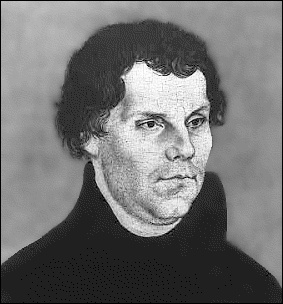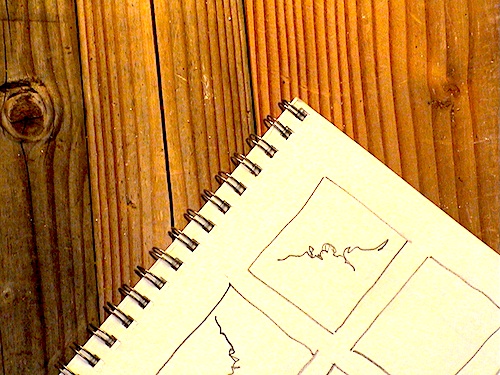The Protestant and the Chaos Magician
 Last month we talked a bit about the work. To do the work, you must define a set of rules and stick to them—a work ethic, if you will. No matter how unstructured and free spirited you are, there's a set of rules you work by. Yes, even you. You have rules about your routine, your self discipline, your priorities. You might not think of them as rules. You might even insist definantly that you have no rules. OK, then "No Rules" would be your rule number one.
Last month we talked a bit about the work. To do the work, you must define a set of rules and stick to them—a work ethic, if you will. No matter how unstructured and free spirited you are, there's a set of rules you work by. Yes, even you. You have rules about your routine, your self discipline, your priorities. You might not think of them as rules. You might even insist definantly that you have no rules. OK, then "No Rules" would be your rule number one.
The rules you operate under are a direct reflection of your personality, priorities, and mindset as an artist. If you see art as your "day job" your rules might be pretty structured and you might treat art as work. You go to the studio at a fixed time every day and stay for a full work day, no matter what. You keep a calendar and a mental timeclock, and you work, regardless of inspiration, in the faith that if you do the work, the art will come. This is an extremely common and well-proven strategy, and it's practitioners tend to throw themselves into it with the zeal of a protestant. In fact we could call this the protestant work ethic of creativity.
On the other hand, there are those who chafe at that idea and approach. If you are one of these, your rules might be more about not allowing a structured orderly workday routine to develop. If this is the case for you, then how do you manage it? You might think you don't. You might think you're such a free spirit that rules aren't needed. People who feel this way often have a set of rules that involve procrastination, emotional chaos, and binge sessions that are extremely turbulent, intensely focused, and shockingly productive. How can that be a set of rules, you ask? Simply put, it's a well defined, highly predictable method of functioning that works perfectly for a certain type of person. And interestingly, there are a lot of artists with this personality type and work style. Such people often appear to be totally flaked out to those who don't or can't work this way. They also tend to be driven almost entirely by emotional energy. Let's call these "chaos magicians".

We're not in a position to say whether one of these styles is better or worse than the other. Both have advantages and disadvantages, and both seem like the only possibility to those who function best within them. What we can say—and it's the point of this article—is that there's no moral imperative to doing it one way or the other. Many of the protestants feel that there is something morally superior about showing up on schedule and working no matter what.
But for some people, this simply does not work. In fact, for most people, only one of these methodologies works at all. And for many, the idea of switching from one to the other is out of the question. So whether you are a protestant or a magician, the key is to do the work your way and don't be intimidated by suggestitons that your method is inadequate. There is only one measurement that matters. Are you getting the work done?
Getting the work done is the real test of your style. If you spend all day "working" in your studio but never seem to deliver finished work, or if you spin around in a perpetual state of chaos and rarely hit the critical productive zone where the magic happens, then you are fooling yourself. No method and no mindset will do the work for you.
Disclaimer: Any similarities of actual Protestants and real Chaos Magicians to the phenomena we have described here are purely metaphorical, or if not, then coincidental.
Sketchbook as Dayplanner
Have you ever kept a day planner? If you're a protestant you might even be keeping one right now. Chaos magicians, as a rule, don't keep day planners. Some try, but generally the everyday routineness of it gets in their way.
For many of us, whether protestant or magician, the sketchbook is ever-present, and captures the full array of left and right brain processes as we use it. Drawings, notes, lists, appointments, diagrams, all flow freely through the pages in a nonlinear flow that is far more effective for the creative mind than a linear grid of one hour time slots, each with its reserved 1.25 x 3.5 inch rectangle.

In fact, as I reflect on this, I realize that my lecture notes in college looked more like my sketchbooks than like traditional lecture notes, and they were very effective for me.
This idea won't be news to some of you, who already think with your sketchpad mapping your brain much of the time anyway. But if this hasn't occurred to you, give it a try. Think of that sketchpad as the doodle pallette that organizes your life. You might be surprised what comes of it.
|

 Last month we talked a bit about the work. To do the work, you must define a set of rules and stick to them—a work ethic, if you will. No matter how unstructured and free spirited you are, there's a set of rules you work by. Yes, even you. You have rules about your routine, your self discipline, your priorities. You might not think of them as rules. You might even insist definantly that you have no rules. OK, then "No Rules" would be your rule number one.
Last month we talked a bit about the work. To do the work, you must define a set of rules and stick to them—a work ethic, if you will. No matter how unstructured and free spirited you are, there's a set of rules you work by. Yes, even you. You have rules about your routine, your self discipline, your priorities. You might not think of them as rules. You might even insist definantly that you have no rules. OK, then "No Rules" would be your rule number one.



